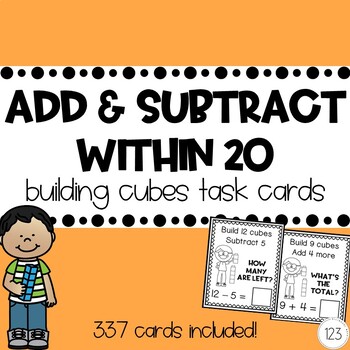Addition and Subtraction within 20 - Unifix Cubes Task Cards
123
1.4k Followers
Grade Levels
PreK - 2nd
Subjects
Resource Type
Standards
CCSSK.CC.B.4a
CCSSK.CC.B.4b
CCSSK.CC.B.5
Formats Included
- PDF
Pages
92 pages
123
1.4k Followers
What educators are saying
My special ed. students really benefit from the simple and engaging materials that allow for frequent practice. This is a really good resource for aligning reading comprehension and developing math fluency with addition and subtraction as you can differentiate within the activity.
This item, unifix cube task cards are an engaging and quick use math center. Glad I found it. Students enjoy it working alone or in groups.
Description
Unifix cubes task cards are a great way for students to practice early addition and subtraction within 20!
Have students follow the directions on the card to add or subtract cubes, then complete the equation. Encourage students to use a different color for the amount being added. Students can record their equation on the recording sheet or write their answer directly on the card (laminate for reuse). Teachers may want to separate cards by number size to ensure students can be successful!
Activity can be done independently or at a small group math center. Check out the preview to see what's included!
Total Pages
92 pages
Answer Key
N/A
Teaching Duration
N/A
Report this resource to TPT
Reported resources will be reviewed by our team. Report this resource to let us know if this resource violates TPT’s content guidelines.
Standards
to see state-specific standards (only available in the US).
CCSSK.CC.B.4a
When counting objects, say the number names in the standard order, pairing each object with one and only one number name and each number name with one and only one object.
CCSSK.CC.B.4b
Understand that the last number name said tells the number of objects counted. The number of objects is the same regardless of their arrangement or the order in which they were counted.
CCSSK.CC.B.5
Count to answer “how many?” questions about as many as 20 things arranged in a line, a rectangular array, or a circle, or as many as 10 things in a scattered configuration; given a number from 1-20, count out that many objects.


